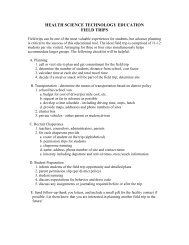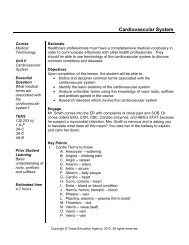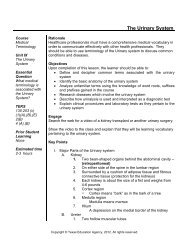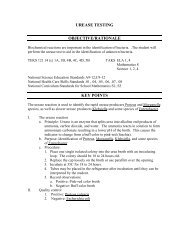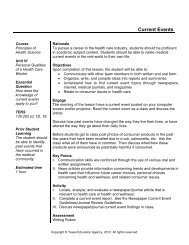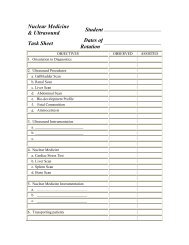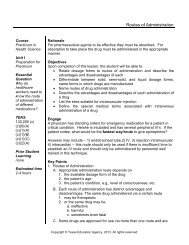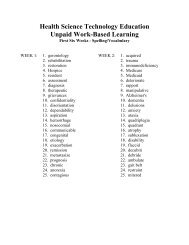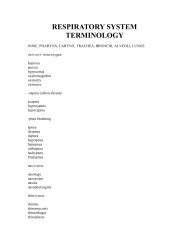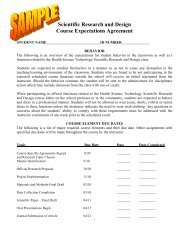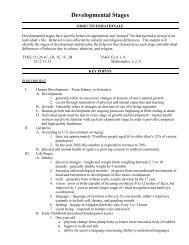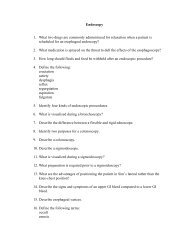Global Infectious Diseases - Health Science Technology Education
Global Infectious Diseases - Health Science Technology Education
Global Infectious Diseases - Health Science Technology Education
Create successful ePaper yourself
Turn your PDF publications into a flip-book with our unique Google optimized e-Paper software.
III. B. 3. Plan and deliver focused and coherent presentations that conveyclear and distinct perspectives and demonstrate solid reasoning.IV. B. 3. Listen actively and effectively in group discussions.V. A. 3. Explore a research topic.V. B. 1. Gather relevant sources.V. B. 2. Evaluate the validity and reliability of sources.V. B. 3. Synthesize and organize information effectively.V. C. 1. Design and present an effective product.<strong>Science</strong>III. B. 3. Recognize scientific and technical vocabulary in the field of studyand use this vocabulary to enhance clarity of communication.III. C. 1. Prepare and present scientific/technical information in appropriateformats for various audiences.III. D. 1. Use search engines, databases, and other digital electronic toolseffectively to locate information.IV. B. 1. Understand how scientific research and technology have an impacton ethical and legal practices.X. E. 5. Understand how human practices affect air, water, and soil quality.Social StudiesI. A. 2. Analyze the interaction between human communities and theenvironment.Cross-DisciplinaryI. A. 1. Engage in scholarly inquiry and dialogue.I. E. 1. Work independently.I. E. 2. Work collaboratively.Sources:World <strong>Health</strong> Organization (WHO)<strong>Global</strong> <strong>Health</strong> CouncilNational Institute of Allergy and <strong>Infectious</strong> <strong>Diseases</strong>ActionBioscience.orgEnvironmental Knowledge for ChangeCopyright © Texas <strong>Education</strong> Agency, 2012. All rights reserved.
Activity IPart I: Track That Disease!Student groups will draw and label a global wall map and track diseases around the world.Materials Blue and green butcher paper (each sheet 4 to 5 feet long) Map of the World Template Pencils Black marker Overhead projectorDirectionsDivide students into six groups Group 1: North America, middle & Central America, and Greenland Group 2: South America Group 3: Europe, Central Asia, and the Middle East Group 4: Africa and Madagascar Group 5: Asia and Southeast Asia Group 6: Australia, New Zealand, and the South PacificMaking the map1. Tape green butcher paper to a wall and project the world map template onto it (I like tomake BIG wall maps and usually tape two strips of butcher paper horizontally beforehanging. Also, I sometimes like to use different colored butcher paper for each continent,but if you want to keep it simple, use all green paper)2. Have a student from each group trace his or her group’s assigned continent (studentscan use a more detailed map to draw their countries)3. Each group will cut out their continent and countries, outline them, and label them withblack marker4. Piece the map together and tape it to the blue butcher paper5. Label the oceans6. Hang it on the wallLater, when students begin tracking diseases (part II of this activity), they can make diseaselabels and tack “outbreak labels” to the corresponding countries around the world.Copyright © Texas <strong>Education</strong> Agency, 2012. All rights reserved.
Map of the World Templatewww.nationsonline.jpgCopyright © Texas <strong>Education</strong> Agency, 2012. All rights reserved.
Materials Disease Cards Student Computers Investigation/Presentation RubricPart II: Track That Disease!IntroductionRead the following information to the class:I will be passing out a list of some of the most common infectious diseases worldwide. Accuratecaseload numbers of these diseases are difficult to determine because so many of them areendemic to developing countries, where many people do not have access to modern medicalcare. However, approximately half of all deaths caused by infectious diseases each year can beattributed to just three diseases: tuberculosis, malaria, and AIDS. Together, these diseasescause over 300 million illnesses and more than 5 million deaths each year.Sources: The Centers for Disease Control (CDC); The World <strong>Health</strong> Organization (WHO).Computer Research1. Assign each group two diseases from the Disease Card list2. Have them fill out their group cards3. After completing the cards, each group needs to track their disease by going to the<strong>Health</strong> Map: http://www.healthmap.org/en/. There is a search box at the top of thiswebpage where the students can type in their assigned diseases4. After seeing where their assigned disease outbreaks are, the student groups can makedisease nametags and paste them to the class wall map in the appropriate countries (Ihave the students track the same diseases for the duration of the course so that they cansee the patterns and movement of diseases)Investigation/Oral Presentation Give each student group a Track That Disease! Evaluation Rubric to help them preparefor their group presentation Student groups complete this activity by giving an oral presentation to the class Grade presentation groups with the Track That Disease! Evaluation RubricCopyright © Texas <strong>Education</strong> Agency, 2012. All rights reserved.
DISEASE CARDSTo help with disease pronunciation, check out howjsay.com.1. AFRICANTRYPANOSOMIASIS(sleeping sickness)PathogenTransmissionSymptoms:2. CHOLERA Pathogen TransmissionSymptoms:3. CRYPTOSPORIDIOSIS Pathogen TransmissionSymptoms:4. DENGUE FEVER Pathogen TransmissionSymptoms:5. EBOLA HEMORRHAGICFEVERPathogenTransmissionSymptoms:Copyright © Texas <strong>Education</strong> Agency, 2012. All rights reserved.
6. HANTA VIRUS Pathogen TransmissionSymptoms:7. HEPATITIS A Pathogen TransmissionSymptoms:8. HEPATITIS B Pathogen TransmissionSymptoms:9. HEPATITIS C Pathogen TransmissionSymptoms:10. HIV/AIDS Pathogen TransmissionSymptoms:Copyright © Texas <strong>Education</strong> Agency, 2012. All rights reserved.
11. INFLUENZA Pathogen TransmissionSymptoms:12. JAPANESE ENCEPHALITIS Pathogen TransmissionSymptoms:13. LEISHMANIASIS Pathogen TransmissionSymptoms:14. MALARIA Pathogen TransmissionSymptoms:15. MEASLES Pathogen TransmissionSymptoms:Copyright © Texas <strong>Education</strong> Agency, 2012. All rights reserved.
16. MENINGITIS Pathogen TransmissionSymptoms:17. ONCHOCERCIASIS“river blindness”PathogenTransmissionSymptoms:18. PNEUMONIA Pathogen TransmissionSymptoms:19. POLIOPathogenTransmissionSymptoms:20. ROTAVIRUS Pathogen TransmissionSymptoms:Copyright © Texas <strong>Education</strong> Agency, 2012. All rights reserved.
21. SEVERE ACUTERESPIRATORYSYNDROME (SARS)PathogenTransmissionSymptoms:22. SCHISTOSOMIASIS Pathogen TransmissionSymptoms:23. SHIGELLOSIS Pathogen TransmissionSymptoms:24. STREP THROAT Pathogen TransmissionSymptoms:25. TUBERCULOSIS (TB) Pathogen TransmissionSymptoms:Copyright © Texas <strong>Education</strong> Agency, 2012. All rights reserved.
26. TYPHOID Pathogen TransmissionSymptoms:27. WEST NILE VIRUS Pathogen TransmissionSymptoms:28. YELLOW FEVER Pathogen TransmissionSymptoms:Copyright © Texas <strong>Education</strong> Agency, 2012. All rights reserved.
Track That Disease! Evaluation/Presentation RubricPeriod _________Date ___________Assigned <strong>Diseases</strong>:1) _______________________________________2) _______________________________________Group Member’s Names __________________________________________________________________________________________________________________________________CriteriaExcellent90-100Very good80-89Average75-79Marginal70-74Failed to meetbasicrequirements60 WALL MAP TEAM WORK:1. Team worked amicably on their map2. Each member was engaged in theproject3. The team stayed focused on the project4. The team completed the map andlabeling in the allotted timeDISEASE INVESTIGATION:Students identified1. pathogen that caused their assigneddiseases2. vector(s) that transmitted their assigneddiseases3. signs and symptoms of their assigneddiseases4. countries where there is an outbreak oftheir assigned diseases5. reasons why their assigned diseasesare prevalent in those countries6. available technology to treat theirassigned diseasesORAL PRESENTATION:1. Lead speaker introduced the team andthe two diseases they trackedCopyright © Texas <strong>Education</strong> Agency, 2012. All rights reserved.
2. Speakers held the audiences’ attention3. Group members spoke clearly andprojected their voices4. Speakers faced the audience (not theprojector screen)5. Each member took an equal part in thepresentation6. Group knew the topic and didn’t readexclusively from index cards or slides7. The presentation was organized andsmooth8. Members were able to reasonablyanswer questions during the Q & AGive points for each grade category and average.Grade ________Teacher Comments:Copyright © Texas <strong>Education</strong> Agency, 2012. All rights reserved.



